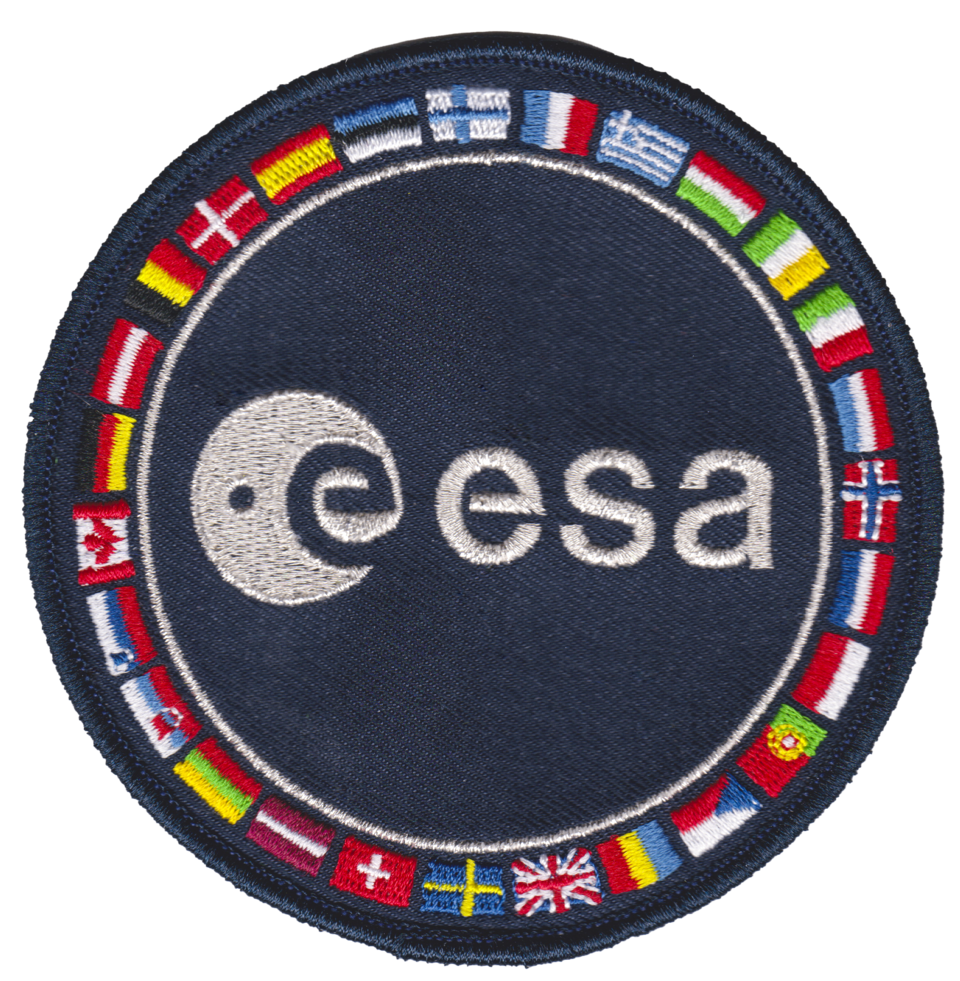4.22.24
Have you ever looked up at the night sky and wondered if there are other planets out there beyond our Solar System?
This question remained an enigma for scientists until just over 30 years ago. In fact, despite the existence of planets beyond our Solar System being hypothesised, it wasn’t until 1992 that the first definite detection occurred. That year, Aleksander Wolszczan and Dale Frail discovered PSR B1257+12 b. A few years later, in 1995, Michel Mayor and Didier Queloz detected the first planet orbiting a star like our Sun, named 51 Pegasi b. This discovery was crucial as it paved the way for the search for exoplanets in star systems like ours. For the first time, astronomers had the certainty that our Solar System was not unique. The hunt for other planetary systems had begun, and an exciting new field of astrophysics had been born: the science of exoplanets.
But why are exoplanets so fascinating? Well, think about it. They could be like Earth, or perhaps totally different. And in both cases it would be an extremely intriguing discovery. The confirmation of the first exoplanet shook our understanding of the Universe. It made us wonder if life exists beyond our planet and if it’s possible to find other planets like our Earth. And if our planet, which has all the necessary characteristics for the emergence of life, is unique.
So, now that we know they exist, how do we find these distant worlds? There are multiple available methods: direct methods try to identify the planet itself, while indirect methods deduce its presence by observing the effect the planet has on the star around which it orbits.


While the first type involves pointing a telescope at a star and taking a picture of its companion, the second type of method focuses, for example, on observing small dips in the apparent brightness of a star when a planet passes in front of it or on detecting minute oscillations in the position of a star caused by an orbiting planet.
The combination of all these methods has allowed the detection of over 5000 celestial bodies to date, which constitute the catalogue of known exoplanets.
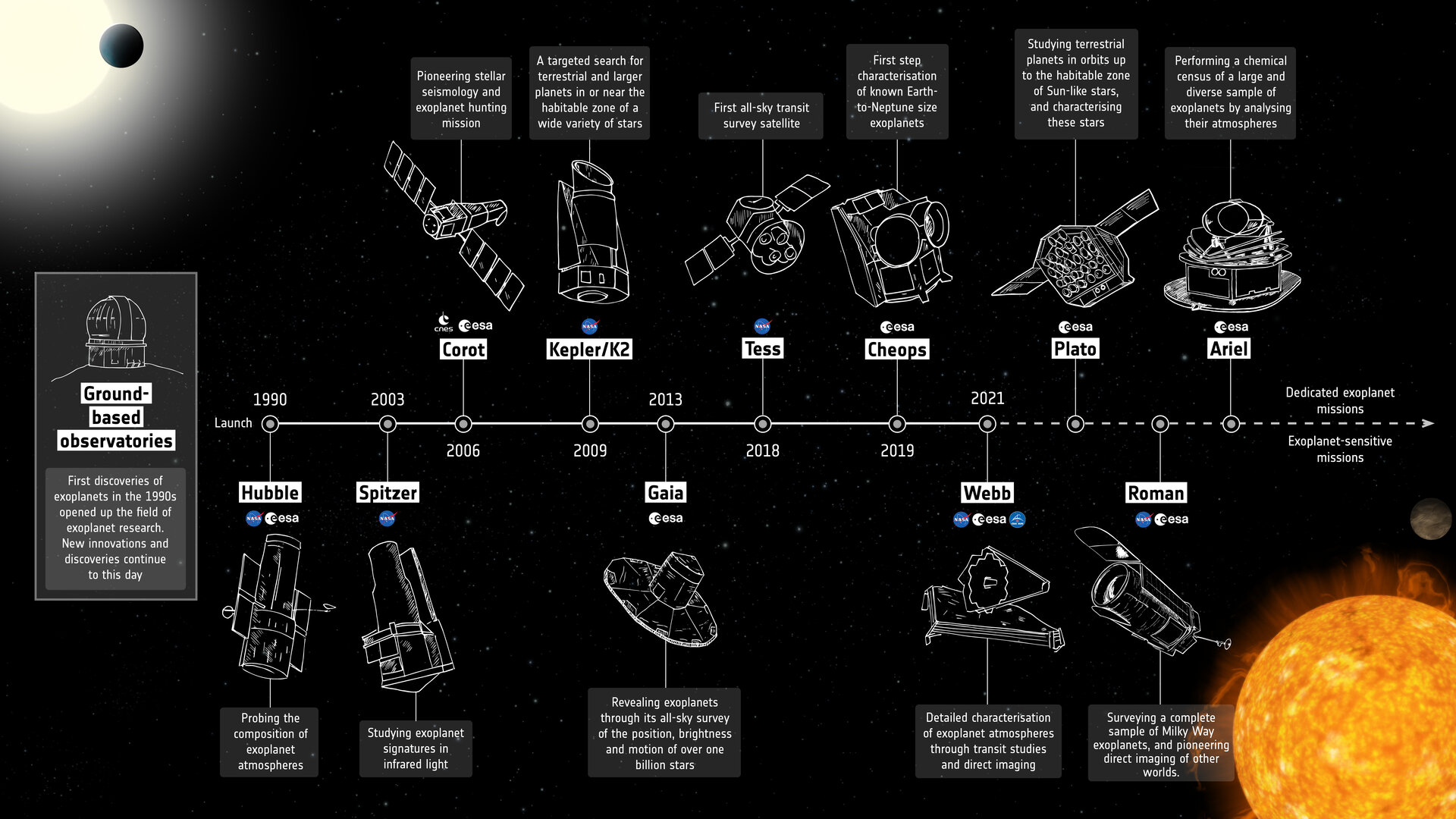
Exoplanet mission timeline showing all ESA missions that contribute to the science of exoplanets.
To conduct these investigations, space detectives are needed: scientific spacecraft capable of studying these celestial bodies. ESA has its dedicated fleet of exoplanet science missions, illustrated in this image and in this video.
ESA’s exoplanet missions
Some of them, designed within the last decade, are specifically aimed at studying exoplanets. Examples are Cheops, the Characterizing Exoplanet Satellite, a satellite that characterizes known exoplanets, and the James Webb Space Telescope, which provides detailed observations of exoplanetary atmospheres. There are also two future missions in the ESA family: Ariel, which aims to study the atmospheres of exoplanets, and Plato, which seeks new exoplanets and studies stars to understand the formation of planetary systems.




In addition to these missions, specifically developed for the search and characterization of exoplanets, another mission plays a key role in this field: Gaia.

Gaia is a cosmic cartographer, mapping out the positions, movements, and other details of over a billion stars in our galaxy and beyond. While Gaia’s main task is to study stars, it is also a treasure trove for finding planets beyond our Solar System. A novel possibility to detect exoplanets is through astrometry, which involves measuring the exact positions of stars. Monitoring star positions over long periods of time, as Gaia does, reveals tiny motions caused by otherwise unseen planets orbiting them. These measurements must be very precise to detect this small effect, much like finding a needle in a haystack. Gaia’s instruments achieve a precision never seen before, making this difficult challenge uniquely possible. With two major data releases still to come, DR4 (expected no sooner than the end of 2025) and DR5, Gaia will produce all-sky exoplanet catalogues containing thousands of new planets.
“If we want to understand how planets are formed, it is necessary to have a vision of how the whole planetary system is composed. Currently, our vision of most systems is only partial because each detection technique is efficient for a certain range of planet sizes and orbital periods. Being able to combine all techniques and data is critical to understand what planetary systems look like and to put our Solar System in context. We still have many questions to investigate. Having more detections of exoplanets with diverse characteristics offers a clearer view of the statistical trends and their implications. The dependence on the galactic environment may also be a key factor: it is important to complete our current picture with planetary systems in more diverse and distant regions of the galaxy.”
Ana Heras, ESA Plato Mission Project Scientist.
Planets discovered by Gaia will typically have masses greater than those of Earth. Gaia will not be able to find any “Earth twin”; nevertheless, adding planets to the catalogue is important: a larger sample allows us to better understand the characteristics and occurrences of the different types of planets that make up the exoplanet zoo.
“If we want to understand Earth-like planets, how they form, how they evolve, and what their atmospheres are composed of, we absolutely also need to understand the formation and evolution of the largest planets. Even if we look for habitability in other systems, it is necessary to understand the whole system and its chemistry and dynamics, including the gas giant planets. Take our own Solar System as an example: Jupiter and Saturn are important for the orbit of Earth, and thus for the development of life. If Saturn had been on a more elliptical orbit or closer to the Sun, Earth’s climate would have developed in a very different way – and this is just one example. The large planets therefore also play a crucial role in the evolution and the habitability of the smaller ones.”
Theresa Lüftinger, ESA Ariel Mission Project Scientist
But Gaia’s contribution doesn’t stop there. The mission also helps us to study the characteristics of the stars around which exoplanets orbit. By collecting properties like size, temperature, and age, we can learn more about the planets themselves. In fact, knowing the characteristics of a star is crucial for studying the planet orbiting it. It provides fundamental information about the environment and conditions in which the star and planet formed and evolved, influencing its composition, atmosphere, and physical properties. These data, collected in Gaia’s star catalogue, serve as a reference point for all other ESA missions focusing on extrasolar planets, both in selecting which planets to observe and in deducing their characteristics.
“Knowing the characteristics of exoplanet host stars is fundamental. In fact, stars and planets interact directly with each other. The star plays a fundamental role in the evolution of the planet: the same planet around a different star could have developed in a completely different way. For this reason, it is important to know the characteristics of the star, and this knowledge provided by Gaia is increasingly recognised within the exoplanet community.”
Theresa Lüftinger, ESA Ariel Mission Project Scientist
ESA missions thus work in optimal synergy, making the most of the data discovered by the Gaia space telescope.
“To determine the properties of exoplanets accurately and precisely, we need to have the best possible knowledge of their host starts. Our exoplanet missions would not be able to achieve as detailed insights as they do without Gaia’s help.”
Maximilian Günther, ESA Cheops Mission Project Scientist
In conclusion, Gaia emerges as a crucial catalyst for the study of exoplanets. With its ability to perform extremely precise astrometric measurements, the mission will soon bring about a paradigm shift in the research area of exoplanets. With the upcoming fourth data release, Gaia is expected to unveil thousands of new planets that will complement the exoplanet zoo we know to date. Furthermore, Gaia will continue to contribute to the characterisation of the host stars of planets, enabling a better understanding of the formation and evolution of planetary systems. Gaia opens new avenues in the search for and study of exoplanets, enriching our understanding of the Universe and its diverse planetary facets.
More information
An in-depth article about Gaia’s role in discovering distant worlds can be found here.
See the full article here .
Comments are invited and will be appreciated, especially if the reader finds any errors which I can correct.

five-ways-keep-your-child-safe-school-shootings
![]()
Please help promote STEM in your local schools.
The European Space Agency [La Agencia Espacial Europea] [Agence spatiale européenne][Europäische Weltraumorganization](EU), established in 1975, is an intergovernmental organization dedicated to the exploration of space, currently with 19 member states. Headquartered in Paris, ESA has a staff of more than 2,000. ESA’s space flight program includes human spaceflight, mainly through the participation in the International Space Station program, the launch and operations of unmanned exploration missions to other planets and the Moon, Earth observation, science, telecommunication as well as maintaining a major spaceport, the Guiana Space Centre at Kourou, French Guiana, and designing launch vehicles. ESA science missions are based at ESTEC (NL) in Noordwijk, Netherlands, Earth Observation missions at ESRIN in Frascati, Italy, ESA Mission Control (ESOC) is in Darmstadt, Germany, the European Astronaut Centre (EAC) that trains astronauts for future missions is situated in Cologne, Germany, and the
European Space Astronomy Centre is located in Villanueva de la Cañada, Spain.

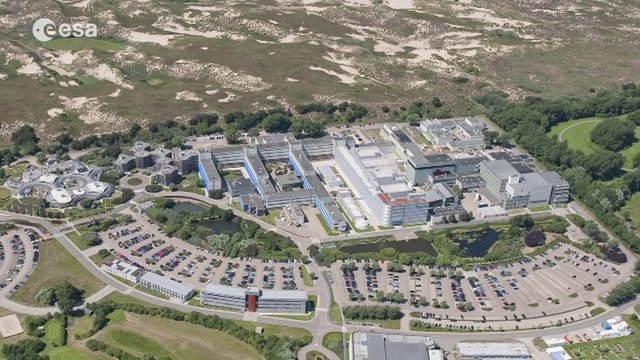

ESA’s space flight programme includes human spaceflight (mainly through participation in the International Space Station program); the launch and operation of uncrewed exploration missions to other planets and the Moon; Earth observation, science and telecommunication; designing launch vehicles; and maintaining a major spaceport, the The Guiana Space Centre [Centre Spatial Guyanais; CSG also called Europe’s Spaceport) at Kourou, French Guiana. The main European launch vehicle Ariane 5 is operated through Arianespace with ESA sharing in the costs of launching and further developing this launch vehicle. The agency is also working with The National Aeronautics and Space Agency to manufacture the Orion Spacecraft service module that will fly on the Space Launch System.
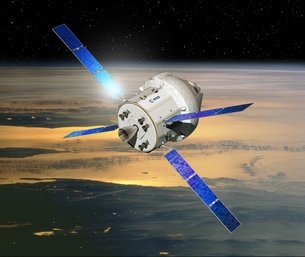



The agency’s facilities are distributed among the following centres:
ESA European Space Research and Technology Centre (ESTEC) (NL) in Noordwijk, Netherlands;
ESA Centre for Earth Observation [ESRIN] (IT) in Frascati, Italy;
ESA Mission Control ESA European Space Operations Center [ESOC](DE) is in Darmstadt, Germany;
ESA -European Astronaut Centre [EAC] trains astronauts for future missions is situated in Cologne, Germany;
European Centre for Space Applications and Telecommunications (ECSAT) (UK), a research institute created in 2009, is located in Harwell, England;
ESA – European Space Astronomy Centre [ESAC] (ES) is located in Villanueva de la Cañada, Madrid, Spain.
European Space Agency Science Programme is a long-term programme of space science and space exploration missions.
Foundation
After World War II, many European scientists left Western Europe in order to work with the United States. Although the 1950s boom made it possible for Western European countries to invest in research and specifically in space-related activities, Western European scientists realized solely national projects would not be able to compete with the two main superpowers. In 1958, only months after the Sputnik shock, Edoardo Amaldi (Italy) and Pierre Auger (France), two prominent members of the Western European scientific community, met to discuss the foundation of a common Western European space agency. The meeting was attended by scientific representatives from eight countries, including Harrie Massey (United Kingdom).
The Western European nations decided to have two agencies: one concerned with developing a launch system, ELDO (European Launch Development Organization) , and the other the precursor of the European Space Agency, ESRO (European Space Research Organization) . The latter was established on 20 March 1964 by an agreement signed on 14 June 1962. From 1968 to 1972, ESRO launched seven research satellites.
ESA in its current form was founded with the ESA Convention in 1975, when ESRO was merged with ELDO. ESA had ten founding member states: Belgium, Denmark, France, West Germany, Italy, the Netherlands, Spain, Sweden, Switzerland, and the United Kingdom. These signed the ESA Convention in 1975 and deposited the instruments of ratification by 1980, when the convention came into force. During this interval the agency functioned in a de facto fashion. ESA launched its first major scientific mission in 1975, Cos-B, a space probe monitoring gamma-ray emissions in the universe, which was first worked on by ESRO.
Later activities



The European Space Agency [La Agencia Espacial Europea] [Agence spatiale européenne][Europäische Weltraumorganization](EU) Copernicus mission.











ESA collaborated with National Aeronautics Space Agency on the International Ultraviolet Explorer (IUE), the world’s first high-orbit telescope, which was launched in 1978 and operated successfully for 18 years.







A number of successful Earth-orbit projects followed, and in 1986 ESA began Giotto, its first deep-space mission, to study the comets Halley and Grigg–Skjellerup. Hipparcos, a star-mapping mission, was launched in 1989 and in the 1990s SOHO, Ulysses and the Hubble Space Telescope were all jointly carried out with NASA. Later scientific missions in cooperation with NASA include the Cassini–Huygens space probe, to which ESA contributed by building the Titan landing module Huygens.

As the successor of ELDO, ESA has also constructed rockets for scientific and commercial payloads. Ariane 1, launched in 1979, carried mostly commercial payloads into orbit from 1984 onward. The next two versions of the Ariane rocket were intermediate stages in the development of a more advanced launch system, the Ariane 4, which operated between 1988 and 2003 and established ESA as the world leader in commercial space launches in the 1990s. Although the succeeding Ariane 5 experienced a failure on its first flight, it has since firmly established itself within the heavily competitive commercial space launch market with 82 successful launches until 2018. The successor launch vehicle of Ariane 5, the Ariane 6, is under development and is envisioned to enter service in the 2020s.
The beginning of the new millennium saw ESA become, along with agencies like National Aeronautics Space Agency, Japan Aerospace Exploration Agency (JP), Indian Space Research Organization (IN), the Canadian Space Agency(CA) and Roscosmos (RU), one of the major participants in scientific space research. Although ESA had relied on co-operation with NASA in previous decades, especially the 1990s, changed circumstances (such as tough legal restrictions on information sharing by the United States military) led to decisions to rely more on itself and on co-operation with Russia. A 2011 press issue thus stated:
“Russia is ESA’s first partner in its efforts to ensure long-term access to space. There is a framework agreement between ESA and the government of the Russian Federation on cooperation and partnership in the exploration and use of outer space for peaceful purposes, and cooperation is already underway in two different areas of launcher activity that will bring benefits to both partners.”
Notable ESA programs include SMART-1, a probe testing cutting-edge space propulsion technology, the Mars Express and Venus Express missions, as well as the development of the Ariane 5 rocket and its role in the ISS partnership. ESA maintains its scientific and research projects mainly for astronomy-space missions such as Corot, launched on 27 December 2006, a milestone in the search for exoplanets.
On 21 January 2019, ArianeGroup and Arianespace announced a one-year contract with ESA to study and prepare for a mission to mine the Moon for lunar regolith.
Mission
The treaty establishing the European Space Agency reads:
The purpose of the Agency shall be to provide for and to promote, for exclusively peaceful purposes, cooperation among European States in space research and technology and their space applications, with a view to their being used for scientific purposes and for operational space applications systems…
ESA is responsible for setting a unified space and related industrial policy, recommending space objectives to the member states, and integrating national programs like satellite development, into the European program as much as possible.
Jean-Jacques Dordain – ESA’s Director General (2003–2015) – outlined the European Space Agency’s mission in a 2003 interview:
“Today space activities have pursued the benefit of citizens, and citizens are asking for a better quality of life on Earth. They want greater security and economic wealth, but they also want to pursue their dreams, to increase their knowledge, and they want younger people to be attracted to the pursuit of science and technology. I think that space can do all of this: it can produce a higher quality of life, better security, more economic wealth, and also fulfill our citizens’ dreams and thirst for knowledge, and attract the young generation. This is the reason space exploration is an integral part of overall space activities. It has always been so, and it will be even more important in the future.”
Activities
According to the ESA website, the activities are:
Observing the Earth
Human Spaceflight
Launchers
Navigation
Space Science
Space Engineering & Technology
Operations
Telecommunications & Integrated Applications
Preparing for the Future
Space for Climate
Programs
Copernicus Programme
Cosmic Vision
ExoMars
FAST20XX
Galileo
Horizon 2000
Living Planet Programme
Mandatory
Every member country must contribute to these programs:
Technology Development Element Program
Science Core Technology Program
General Study Program
European Component Initiative
Optional
Depending on their individual choices the countries can contribute to the following programs, listed according to:
Launchers
Earth Observation
Human Spaceflight and Exploration
Telecommunications
Navigation
Space Situational Awareness
Technology
ESA_LAB@
ESA has formed partnerships with universities. ESA_LAB@ refers to research laboratories at universities. Currently there are ESA_LAB@
Technische Universität Darmstadt (DE)
École des hautes études commerciales de Paris (HEC Paris) (FR)
Université de recherche Paris Sciences et Lettres (FR)
The University of Central Lancashire (UK)
Membership and contribution to ESA
By 2015, ESA was an intergovernmental organization of 22 member states. Member states participate to varying degrees in the mandatory (25% of total expenditures in 2008) and optional space programs (75% of total expenditures in 2008). The 2008 budget amounted to €3.0 billion whilst the 2009 budget amounted to €3.6 billion. The total budget amounted to about €3.7 billion in 2010, €3.99 billion in 2011, €4.02 billion in 2012, €4.28 billion in 2013, €4.10 billion in 2014 and €4.33 billion in 2015. English is the main language within ESA. Additionally, official documents are also provided in German and documents regarding the Spacelab are also provided in Italian. If found appropriate, the agency may conduct its correspondence in any language of a member state.
Non-full member states
Slovenia
Since 2016, Slovenia has been an associated member of the ESA.
Latvia
Latvia became the second current associated member on 30 June 2020, when the Association Agreement was signed by ESA Director Jan Wörner and the Minister of Education and Science of Latvia, Ilga Šuplinska in Riga. The Saeima ratified it on July 27. Previously associated members were Austria, Norway and Finland, all of which later joined ESA as full members.
Canada
Since 1 January 1979, Canada has had the special status of a Cooperating State within ESA. By virtue of this accord, The Canadian Space Agency [Agence spatiale canadienne, ASC] (CA) takes part in ESA’s deliberative bodies and decision-making and also in ESA’s programs and activities. Canadian firms can bid for and receive contracts to work on programs. The accord has a provision ensuring a fair industrial return to Canada. Canada has continually increased its annual contribution.
Enlargement
After the decision of the ESA Council of 21/22 March 2001, the procedure for accession of the European states was detailed as described the document titled The Plan for European Co-operating States (PECS). Nations that want to become a full member of ESA do so in 3 stages. First a Cooperation Agreement is signed between the country and ESA. In this stage, the country has very limited financial responsibilities. If a country wants to co-operate more fully with ESA, it signs a European Cooperating State (ECS) Agreement. The ECS Agreement makes companies based in the country eligible for participation in ESA procurements. The country can also participate in all ESA programs, except for the Basic Technology Research Programme. While the financial contribution of the country concerned increases, it is still much lower than that of a full member state. The agreement is normally followed by a Plan For European Cooperating State (or PECS Charter). This is a 5-year programme of basic research and development activities aimed at improving the nation’s space industry capacity. At the end of the 5-year period, the country can either begin negotiations to become a full member state or an associated state or sign a new PECS Charter.
During the Ministerial Meeting in December 2014, ESA ministers approved a resolution calling for discussions to begin with Israel, Australia and South Africa on future association agreements. The ministers noted that “concrete cooperation is at an advanced stage” with these nations and that “prospects for mutual benefits are existing”.
A separate space exploration strategy resolution calls for further co-operation with the United States, Russia and China on “LEO” exploration, including a continuation of ISS cooperation and the development of a robust plan for the coordinated use of space transportation vehicles and systems for exploration purposes, participation in robotic missions for the exploration of the Moon, the robotic exploration of Mars, leading to a broad Mars Sample Return mission in which Europe should be involved as a full partner, and human missions beyond LEO in the longer term.”
Relationship with the European Union
The political perspective of the European Union (EU) was to make ESA an agency of the EU. The EU member states provide most of ESA’s funding, and they are all either full ESA members or observers.
History
At the time ESA was formed, its main goals did not encompass human space flight; rather it considered itself to be primarily a scientific research organization for uncrewed space exploration in contrast to its American and Soviet counterparts. It is therefore not surprising that the first non-Soviet European in space was not an ESA astronaut on a European space craft; it was Czechoslovak Vladimír Remek who in 1978 became the first non-Soviet or American in space (the first man in space being Yuri Gagarin of the Soviet Union) – on a Soviet Soyuz spacecraft, followed by the Pole Mirosław Hermaszewski and East German Sigmund Jähn in the same year. This Soviet co-operation programme, known as Intercosmos, primarily involved the participation of Eastern bloc countries. In 1982, however, Jean-Loup Chrétien became the first non-Communist Bloc astronaut on a flight to the Soviet Salyut 7 space station.
Because Chrétien did not officially fly into space as an ESA astronaut, but rather as a member of the French CNES astronaut corps, the German Ulf Merbold is considered the first ESA astronaut to fly into space. He participated in the STS-9 Space Shuttle mission that included the first use of the European-built Spacelab in 1983. STS-9 marked the beginning of an extensive ESA/NASA joint partnership that included dozens of space flights of ESA astronauts in the following years. Some of these missions with Spacelab were fully funded and organizationally and scientifically controlled by ESA (such as two missions by Germany and one by Japan) with European astronauts as full crew members rather than guests on board. Beside paying for Spacelab flights and seats on the shuttles, ESA continued its human space flight co-operation with the Soviet Union and later Russia, including numerous visits to Mir.
During the latter half of the 1980s, European human space flights changed from being the exception to routine and therefore, in 1990, the European Astronaut Centre in Cologne, Germany was established. It selects and trains prospective astronauts and is responsible for the co-ordination with international partners, especially with regard to the International Space Station. As of 2006, the ESA astronaut corps officially included twelve members, including nationals from most large European countries except the United Kingdom.
In the summer of 2008, ESA started to recruit new astronauts so that final selection would be due in spring 2009. Almost 10,000 people registered as astronaut candidates before registration ended in June 2008. Over 8,000 fulfilled the initial application criteria. Of the applicants, over 900 were chosen to take part in the first stage of psychological testing, which narrowed down the field to 200. After two-stage psychological tests and medical evaluation in early 2009, as well as formal interviews, six new members of the European Astronaut Corps were selected – five men and one woman.
Cooperation with other countries and organizations
ESA has signed co-operation agreements with the following states that currently neither plan to integrate as tightly with ESA institutions as Canada, nor envision future membership of ESA: Argentina, Brazil, China, India (for the Chandrayan mission), Russia and Turkey.
Additionally, ESA has joint projects with the European Union, NASA of the United States and is participating in the International Space Station together with the United States (NASA), Russia and Japan (JAXA).
European Union
ESA and EU member states
ESA-only members
EU-only members
ESA is not an agency or body of the European Union (EU), and has non-EU countries (Norway, Switzerland, and the United Kingdom) as members. There are however ties between the two, with various agreements in place and being worked on, to define the legal status of ESA with regard to the EU.
There are common goals between ESA and the EU. ESA has an EU liaison office in Brussels. On certain projects, the EU and ESA co-operate, such as the upcoming Galileo satellite navigation system. Space policy has since December 2009 been an area for voting in the European Council. Under the European Space Policy of 2007, the EU, ESA and its Member States committed themselves to increasing co-ordination of their activities and programs and to organizing their respective roles relating to space.
The Lisbon Treaty of 2009 reinforces the case for space in Europe and strengthens the role of ESA as an R&D space agency. Article 189 of the Treaty gives the EU a mandate to elaborate a European space policy and take related measures, and provides that the EU should establish appropriate relations with ESA.
Former Italian astronaut Umberto Guidoni, during his tenure as a Member of the European Parliament from 2004 to 2009, stressed the importance of the European Union as a driving force for space exploration, “…since other players are coming up such as India and China it is becoming ever more important that Europeans can have an independent access to space. We have to invest more into space research and technology in order to have an industry capable of competing with other international players.”
The first EU-ESA International Conference on Human Space Exploration took place in Prague on 22 and 23 October 2009. A road map which would lead to a common vision and strategic planning in the area of space exploration was discussed. Ministers from all 29 EU and ESA members as well as members of parliament were in attendance.
National space organizations of member states:
The Centre National d’Études Spatiales(FR) (CNES) (National Centre for Space Study) is the French government space agency (administratively, a “public establishment of industrial and commercial character”). Its headquarters are in central Paris. CNES is the main participant on the Ariane project. Indeed, CNES designed and tested all Ariane family rockets (mainly from its centre in Évry near Paris)
The UK Space Agency is a partnership of the UK government departments which are active in space. Through the UK Space Agency, the partners provide delegates to represent the UK on the various ESA governing bodies. Each partner funds its own programme.
The Italian Space Agency A.S.I. – Agenzia Spaziale Italiana was founded in 1988 to promote, co-ordinate and conduct space activities in Italy. Operating under the Ministry of the Universities and of Scientific and Technological Research, the agency cooperates with numerous entities active in space technology and with the president of the Council of Ministers. Internationally, the ASI provides Italy’s delegation to the Council of the European Space Agency and to its subordinate bodies.
The German Aerospace Center (DLR)[Deutsches Zentrum für Luft- und Raumfahrt e. V.] is the national research centre for aviation and space flight of the Federal Republic of Germany and of other member states in the Helmholtz Association. Its extensive research and development projects are included in national and international cooperative programs. In addition to its research projects, the centre is the assigned space agency of Germany bestowing headquarters of German space flight activities and its associates.
The Instituto Nacional de Técnica Aeroespacial (INTA)(ES) (National Institute for Aerospace Technique) is a Public Research Organization specialized in aerospace research and technology development in Spain. Among other functions, it serves as a platform for space research and acts as a significant testing facility for the aeronautic and space sector in the country.
National Aeronautics Space Agency
ESA has a long history of collaboration with NASA. Since ESA’s astronaut corps was formed, the Space Shuttle has been the primary launch vehicle used by ESA’s astronauts to get into space through partnership programs with NASA. In the 1980s and 1990s, the Spacelab programme was an ESA-NASA joint research programme that had ESA develop and manufacture orbital labs for the Space Shuttle for several flights on which ESA participate with astronauts in experiments.
In robotic science mission and exploration missions, NASA has been ESA’s main partner. Cassini–Huygens was a joint NASA-ESA mission, along with the Infrared Space Observatory, INTEGRAL, SOHO, and others.



Also, the Hubble Space Telescope is a joint project of NASA and ESA.

ESA-NASA joint projects include the James Webb Space Telescope and the proposed Laser Interferometer Space Antenna.

____________________
ESA/NASA eLISA space based gravitational wave hunter system




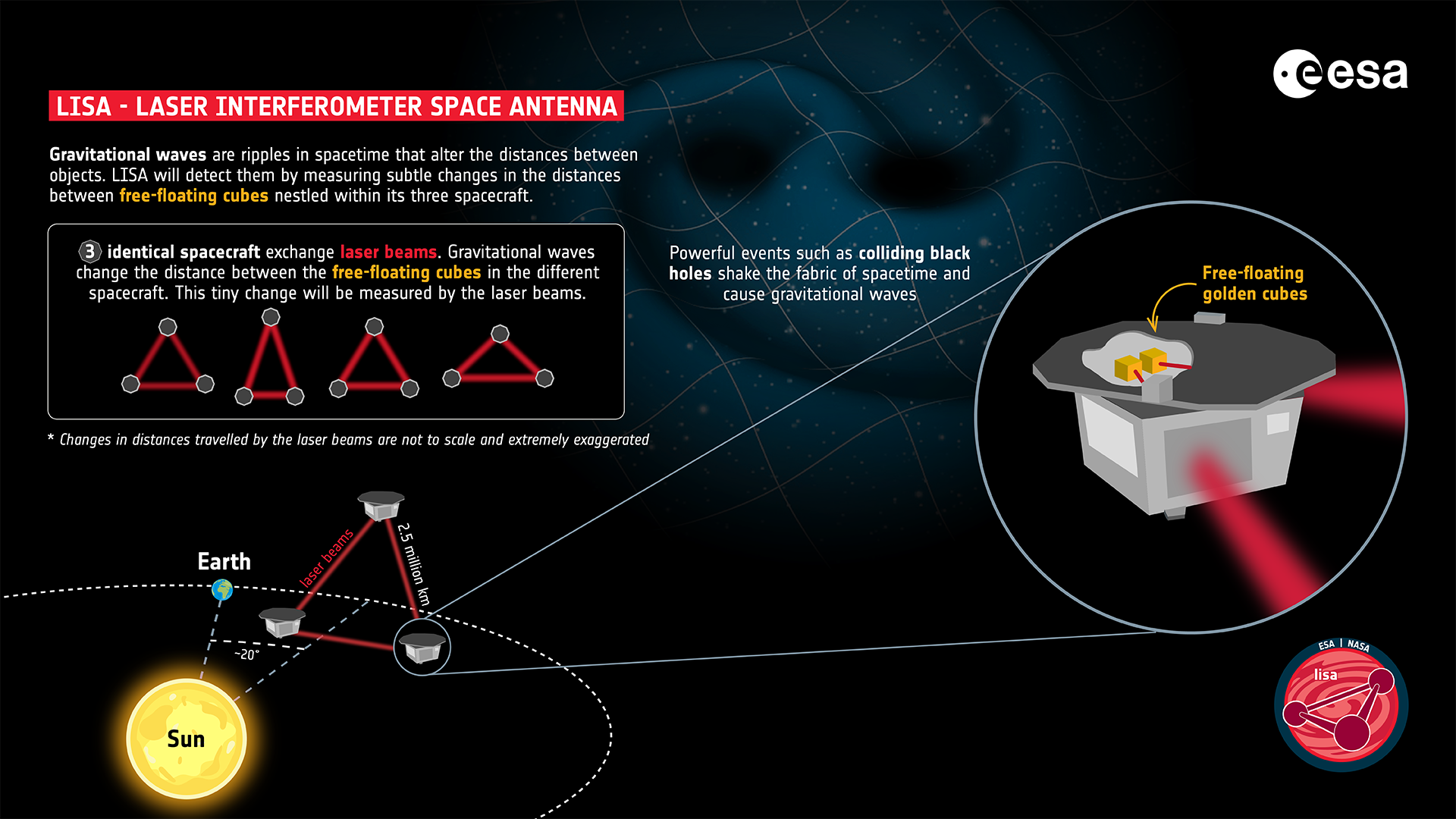
LISA – measuring gravitational waves.
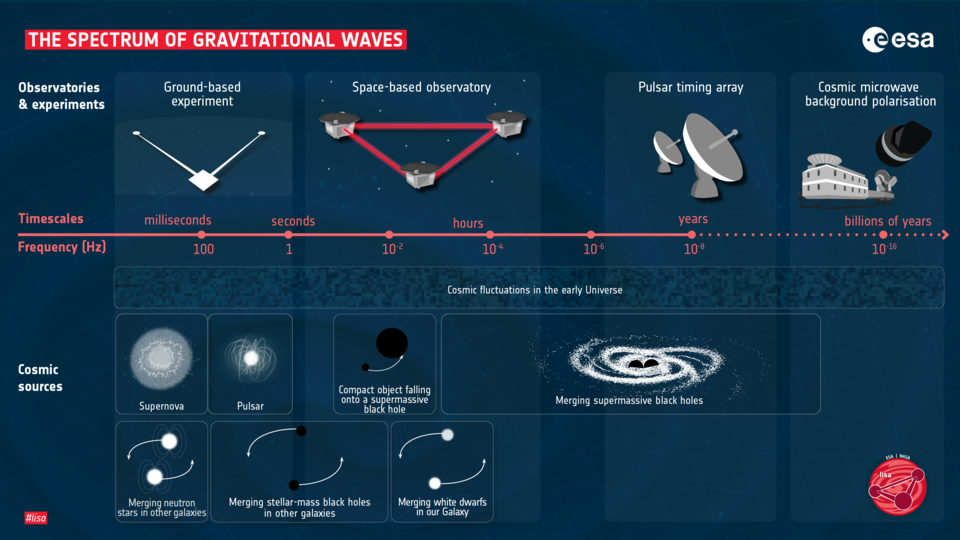
The spectrum of gravitational waves
____________________
NASA has committed to provide support to ESA’s proposed MarcoPolo-R mission to return an asteroid sample to Earth for further analysis. NASA and ESA will also likely join together for a Mars Sample Return Mission. In October 2020 the ESA entered into a memorandum of understanding (MOU) with NASA to work together on the Artemis program, which will provide an orbiting lunar gateway and also accomplish the first manned lunar landing in 50 years, whose team will include the first woman on the Moon.

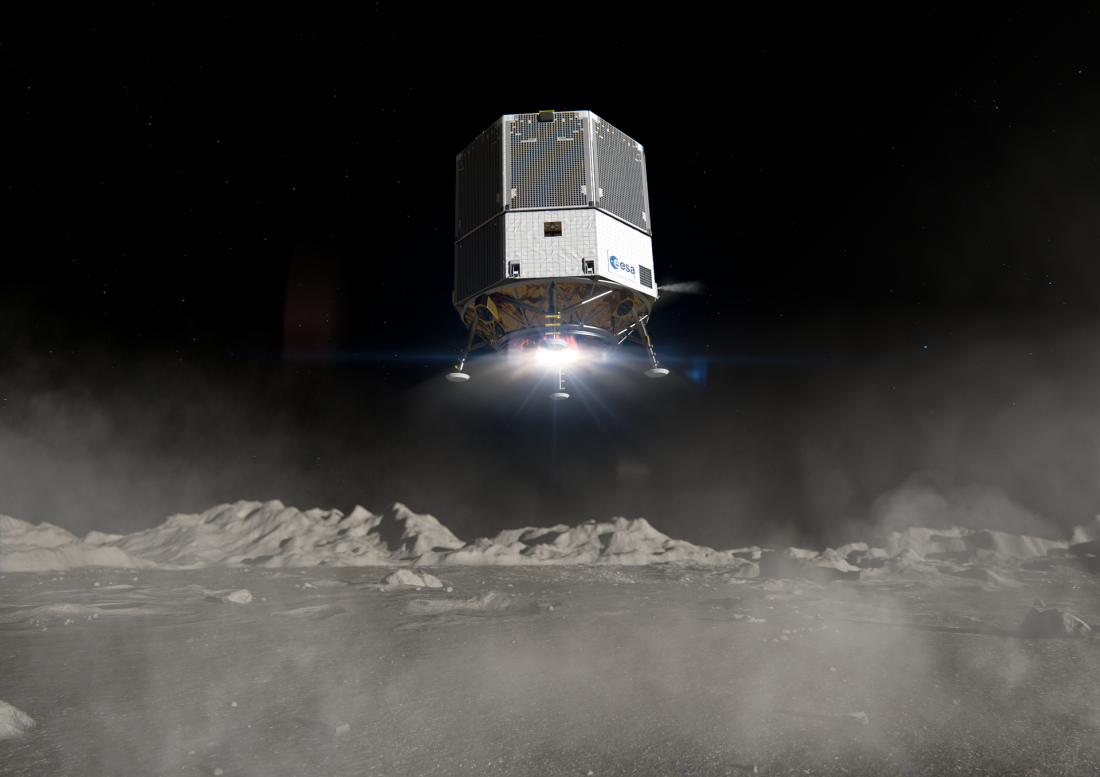
Cooperation with other space agencies
Since China has started to invest more money into space activities, the Chinese Space Agency[中国国家航天局] (CN) has sought international partnerships. ESA is, beside, The Russian Federal Space Agency Государственная корпорация по космической деятельности «Роскосмос»](RU) one of its most important partners. Two space agencies cooperated in the development of the Double Star Mission. In 2017, ESA sent two astronauts to China for two weeks sea survival training with Chinese astronauts in Yantai, Shandong.
ESA entered into a major joint venture with Russia in the form of the CSTS, the preparation of French Guiana spaceport for launches of Soyuz-2 rockets and other projects. With India, ESA agreed to send instruments into space aboard the ISRO’s Chandrayaan-1 in 2008. ESA is also co-operating with Japan, the most notable current project in collaboration with JAXA is the BepiColombo mission to Mercury.

ESA’s Mercury Planetary Orbiter (MPO) will be operated from ESOC Germany.
Speaking to reporters at an air show near Moscow in August 2011, ESA head Jean-Jacques Dordain said ESA and Russia’s Roskosmos space agency would “carry out the first flight to Mars together.”

For the future







